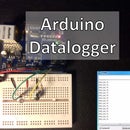Introduction: Arduino - Control LEDs With a Remote Control
Hi guys,
I'm sharing with you a project I've recently done. I'ts about how you can control some LED's with a remote control and your Arduino. But you can apply this to any electronic device such as motors , lights for example.
you can visit my website for more electronic projects, interesting news and tips:
http://randomnerdtutorials.com/
Step 1: IR Library
First you need to go to this page and download the IR library. You just need to follow the read me file to install. I think that any IR remote control can do this, I’ll be using a Philips Universal one.
Step 2: Parts Required
Parts list:
1x Arduino
1x Breadboard
1x Remote control
1x IR receiver ( I’ll be using TSOP4838)
4x LED’s
4x 220ohm resistors
Jumper cables
The infrared receiver has 3 pins:
First pin: Vout, outputs HIGH when no signal is present and LOW when a mark is received.
Second pin: GND.
Third pin: Vcc.
Step 3: Circuit Diagram
You need to wire your circuit something like this.
And then I went to the arduino IDE > file>examples>IRremote> IRrecvDemo. You need to upload the sketch to your arduino, open the serial monitor and start using your remote control and see which values the arduino is receiving.
After a while I’ve wrote down which values appear in the serial monitor when you press the volume up key or any other key, and write it down for all the keys you want to use. And they were:
Power: E240
Forward: E250
Reverse: E248
Volume+: E244
Volume-: E254
Mute: E24C7
You will need to convert these hexadecimal numbers to decimal, you can use this tool for that.
Step 4: Upload the Arduino Code
Upload this code
/*
* IRremote Library - Copyright 2009 Ken Shirriff
* created by Rui Santos, http://randomnerdtutorials.wordpress.com
* Control LED's with a remote control
* 2013
*/
#include <IRremote.h>
int IR_Recv = 3; //IR Receiver Pin 3
int g_ledPin = 5; //green LED pin 5
int y_ledPin = 6; //yellow LED pin 6
int r_ledPin = 9; //red LED pin 9
int b_ledPin = 10; //blue LED pin 10
int ledPins[] = {5, 6, 9, 10}; //array with all the LED's pins
int ledStates[] ={0, 0, 0, 0}; //this means the LED's states at first is 0 = LOW
int i=0; //LED index for the arrays
IRrecv irrecv(IR_Recv);
decode_results results;
//variables to make the LED blink when selected
int ledState = LOW; // ledState to turn the LED on or off
long previousMillis = 0; // stores last time LED was updated
long interval = 1000; // interval at which to blink (milliseconds)
void setup(){
Serial.begin(9600); //starts serial communication
irrecv.enableIRIn(); // Starts the receiver
pinMode(g_ledPin, OUTPUT); // sets the digital pin as output
pinMode(y_ledPin, OUTPUT); // sets the digital pin as output
pinMode(r_ledPin, OUTPUT); // sets the digital pin as output
pinMode(b_ledPin, OUTPUT); // sets the digital pin as output
}
void loop(){
//decodes the infrared input
if (irrecv.decode(&results)){
long int decCode = results.value;
Serial.println(decCode);
//switch case to use the selected remote control button
switch (results.value){
case 57936: //when you press the Forward button
//this if/else statement makes sure that LED is ON or OFF before move to the next LED
if(ledStates[i]==0)
digitalWrite(ledPins[i], LOW);
else
digitalWrite(ledPins[i], HIGH);
Serial.println("Next LED");
//makes sure that when we reach the last LED it goes to the first LED again
if(i>=3)
i=-1;
i+=1;
break;
case 57928: //when you press the Reverse button
//this if/else statement makes sure that LED is ON or OFF before move to the previous LED
if(ledStates[i]==0)
digitalWrite(ledPins[i], LOW);
else
digitalWrite(ledPins[i], HIGH);
Serial.println("Previous LED");
//makes sure that when we reach the first LED it goes to the last LED
if(i<=0)
i=4;
i-=1;
break;
case 57932: //when you press the Mute button
if(ledStates[i]==0){ //if the LED is off, It will turn on
Serial.println("Turns ON the LED Selected");
digitalWrite(ledPins[i], HIGH); //sets the LED on
ledStates[i]=1; //updates the LED state
}
else{
Serial.println("Turns OFF the LED Selected"); //else: the LED is on, It will turn off
digitalWrite(ledPins[i], LOW); //sets the LED off
ledStates[i]=0; //updates the LED state
}
break;
case 57920: //when you press the Power button
Serial.println("Turns OFF all the LED's");
digitalWrite(g_ledPin, LOW); // sets the green LED off
ledStates[0] =0; // updates the LED state
digitalWrite(y_ledPin, LOW); // sets the yellow LED off
ledStates[1] =0; // updates the LED state
digitalWrite(r_ledPin, LOW); // sets the red LED off
ledStates[2] =0; // updates the LED state
digitalWrite(b_ledPin, LOW); // sets the blue LED off
ledStates[3] =0; // updates the LED state
break;
default:
Serial.println("Waiting");
}
irrecv.resume(); // Receives the next value from the button you press
}
//this if statment makes the LED blink if it's selected and off
if(ledStates[i]==0){
unsigned long currentMillis = millis();
if(currentMillis - previousMillis > interval) {
// save the last time you blinked the LED
previousMillis = currentMillis;
// if the LED is off turn it on and vice-versa:
if (ledState == LOW)
ledState = HIGH;
else
ledState = LOW;
// set the LED with the ledState of the variable:
digitalWrite(ledPins[i], ledState)
}
}
}
Step 5: And It's Done
Thanks for reading, let me know what you think about my projects, leave a comment and don't forget to visit my website for more tutorials.
http://randomnerdtutorials.com/
<iframe width="560" height="315" src="http://www.youtube.com/embed/lQ7K8Jp3Jns" frameborder="0" allowfullscreen></iframe>













